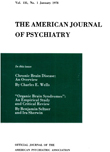On the course of anorexia nervosa
Abstract
The authors trace three phases in the course of anorexia nervosa and compare its physical and psychological symptoms with those of starvation. Phase I, which may occur months or years before the illness, usually includes precipitating events that result in loss of self-esteem and increased self-consciousness about physical appearance. During phase II patients develop the "anorectic attitude," an unreasonable fear of eating, and show pride in their ability to lose weight. By phase III patients are forced by the severity of starvation symptoms to admit that they are ill. Although many of the physical symptoms of starvation and anorexia nervosa are similar, anorectic patients, in contrast to victims of starvation, show high initiative, the ability to suppress hunger, restless hyperactivity, and body image distortion.
Access content
To read the fulltext, please use one of the options below to sign in or purchase access.- Personal login
- Institutional Login
- Sign in via OpenAthens
- Register for access
-
Please login/register if you wish to pair your device and check access availability.
Not a subscriber?
PsychiatryOnline subscription options offer access to the DSM-5 library, books, journals, CME, and patient resources. This all-in-one virtual library provides psychiatrists and mental health professionals with key resources for diagnosis, treatment, research, and professional development.
Need more help? PsychiatryOnline Customer Service may be reached by emailing [email protected] or by calling 800-368-5777 (in the U.S.) or 703-907-7322 (outside the U.S.).



